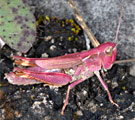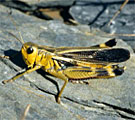Leptophyes albovittata (Kollar, 1833)
![Leptophyes albovittata: Male (Fränkische Alb) [N] Leptophyes albovittata: Male (Fränkische Alb) [N]](thumbs/tettigoniidae/albovittata_m.jpg)
![Leptophyes albovittata: Male (Fränkische Alb) [N] Leptophyes albovittata: Male (Fränkische Alb) [N]](thumbs/tettigoniidae/albovittata_m2.jpg)
![Leptophyes albovittata: Male (Fränkische Alb, Bavaria) [N] Leptophyes albovittata: Male (Fränkische Alb, Bavaria) [N]](thumbs/tettigoniidae/albovittata_m3.jpg)
![Leptophyes albovittata: Male in heat avoidance posture [N] Leptophyes albovittata: Male in heat avoidance posture [N]](thumbs/tettigoniidae/albovittata_mh.jpg)
![Leptophyes albovittata: Female (Fränkische Alb, Bavaria) [N] Leptophyes albovittata: Female (Fränkische Alb, Bavaria) [N]](thumbs/tettigoniidae/albovittata_w.jpg)
![Leptophyes albovittata: Female (Fränkische Alb, Bavaria) [N] Leptophyes albovittata: Female (Fränkische Alb, Bavaria) [N]](thumbs/tettigoniidae/albovittata_w2.jpg)
![Leptophyes albovittata: Female with spermatophore (Fränkische Alb, Bavaria, 2008) [N] Leptophyes albovittata: Female with spermatophore (Fränkische Alb, Bavaria, 2008) [N]](thumbs/tettigoniidae/albovittata_w3.jpg)
![Leptophyes albovittata: Female (Engadine) [N] Leptophyes albovittata: Female (Engadine) [N]](thumbs/tettigoniidae/albovittata_w4.jpg)
![Leptophyes albovittata: Female (Olympus, July 2010) [N] Leptophyes albovittata: Female (Olympus, July 2010) [N]](thumbs/tettigoniidae/albovittata_w2010.jpg)
![Leptophyes albovittata: Female (Olympus, July 2010) [N] Leptophyes albovittata: Female (Olympus, July 2010) [N]](thumbs/tettigoniidae/albovittata_2w2010.jpg)

![Leptophyes albovittata: Female (Bulgaria, low foothills of Pirin, early August 2013) [N] Leptophyes albovittata: Female (Bulgaria, low foothills of Pirin, early August 2013) [N]](thumbs/tettigoniidae/albovittata_2im2013.jpg)
![Leptophyes albovittata: Male (Olympus, Greece, July 2010) [N] Leptophyes albovittata: Male (Olympus, Greece, July 2010) [N]](thumbs/tettigoniidae/albovittata_m2010.jpg)
![Leptophyes albovittata: Male (Olympus, Greece, July 2010) [N] Leptophyes albovittata: Male (Olympus, Greece, July 2010) [N]](thumbs/tettigoniidae/albovittata_2m2010.jpg)
![Leptophyes albovittata: Habitat (Fränkische Alb, Bavaria, August 2008) [N] Leptophyes albovittata: Habitat (Fränkische Alb, Bavaria, August 2008) [N]](thumbs/tettigoniidae/albovittata_h.jpg)
![Leptophyes albovittata: Habitat in Bulgaria (early August 2013) [N] Leptophyes albovittata: Habitat in Bulgaria (early August 2013) [N]](thumbs/tettigoniidae/albovittata_h2013.jpg)
Nutrition:
The species feeds on herbs and there causes a typical feeding pattern, which can be observed at about thistles (Cirsium vulgare).
Habitat:
Leptophyes albovittata primarily inhabits dry warm hems which are dominated by higher perennials (Geranion sanguinei and related plant communities). It also penetrates alternating wet or ruderalized areas and preferably light to medium shrubby successional stages.
Life cycle:
The adults occur from late June to October. They usually sit on higher perennials. I met many individuals on already fruiting Cirsium vulgare plants whose leaves were literally perforated (pitting, Franconian Alb in northern Bavaria).
Endangerment: endangered
Endangerment factors:
Leptophyes albovittata is threatened by increasing reforestation of habitats, their eutrophication, but also too rigorous shrub removal. Leptophyes albovittata loses many habitats by overbuilding and intensification, e.g. by the famous salami tactics of farmers who like to integrate every year another piece of the few remaining habitats in their fields.
Remarks:
The southeastern distributed species (Western Asia, Southeastern Europe) occurs to the northwest as far as southern Poland and Bavaria (Franconian Alb) and has already reached sporadically Baden-Württemberg. Moreover, Leptophyes albovittata has reached the Swiss Engadine.
Leptophyes boscii | Leptophyes laticauda | Leptophyes lisae | Leptophyes punctatissima


